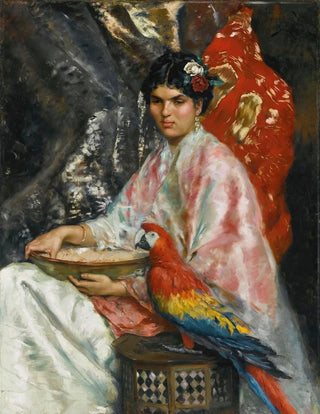Art print | Dame au perroquet - Julius LeBlanc Stewart


View from behind

Frame (optional)
In the vibrant world of 19th-century painting, "Reproduction Dame au perroquet" by Julius LeBlanc Stewart stands out for its elegance and refinement. This artwork, capturing a moment of life imbued with sophistication, transports us to a realm where beauty and nature meet. The captivating gaze of the lady, combined with the colorful presence of the parrot, creates an atmosphere of mystery and seduction. The composition, both intimate and grandiose, invites viewers to reflect on the relationship between humanity and the animal world, while celebrating feminine grace.
Style and uniqueness of the artwork
Stewart's style is characterized by meticulous attention to detail and a rich, nuanced color palette. In "Reproduction Dame au perroquet," the vibrant hues of the bird's feathers contrast with the softer tones of the woman's clothing, creating a striking visual dialogue. Light plays a crucial role in this piece, subtly illuminating the lady's face and highlighting the delicate textures of her dress. The woman's pose, both poised and natural, reveals psychological depth that engages the viewer. Stewart manages to capture a timeless essence, making this artwork not only a portrait but also an exploration of human emotions and the fleeting beauty of life.
The artist and his influence
Julius LeBlanc Stewart, born in 1855, established himself as a major painter of his era, influenced by Impressionist and Post-Impressionist currents. His training in Paris, at the heart of the artistic movements of the late 19th century, allowed him to refine his unique style. Stewart often explored themes related to beauty and sensuality, focusing on portraits of women in luxurious settings. His work demonstrates impressive technical mastery, combined with sensitivity to emotional nuances. By incorporating elements of nature into his compositions, he paved the way for a new approach to portrait painting, where the human subject exists in perfect harmony with its environment.
An exceptional wall decoration signed Artem Legrand

Matte finish

View from behind

Frame (optional)
In the vibrant world of 19th-century painting, "Reproduction Dame au perroquet" by Julius LeBlanc Stewart stands out for its elegance and refinement. This artwork, capturing a moment of life imbued with sophistication, transports us to a realm where beauty and nature meet. The captivating gaze of the lady, combined with the colorful presence of the parrot, creates an atmosphere of mystery and seduction. The composition, both intimate and grandiose, invites viewers to reflect on the relationship between humanity and the animal world, while celebrating feminine grace.
Style and uniqueness of the artwork
Stewart's style is characterized by meticulous attention to detail and a rich, nuanced color palette. In "Reproduction Dame au perroquet," the vibrant hues of the bird's feathers contrast with the softer tones of the woman's clothing, creating a striking visual dialogue. Light plays a crucial role in this piece, subtly illuminating the lady's face and highlighting the delicate textures of her dress. The woman's pose, both poised and natural, reveals psychological depth that engages the viewer. Stewart manages to capture a timeless essence, making this artwork not only a portrait but also an exploration of human emotions and the fleeting beauty of life.
The artist and his influence
Julius LeBlanc Stewart, born in 1855, established himself as a major painter of his era, influenced by Impressionist and Post-Impressionist currents. His training in Paris, at the heart of the artistic movements of the late 19th century, allowed him to refine his unique style. Stewart often explored themes related to beauty and sensuality, focusing on portraits of women in luxurious settings. His work demonstrates impressive technical mastery, combined with sensitivity to emotional nuances. By incorporating elements of nature into his compositions, he paved the way for a new approach to portrait painting, where the human subject exists in perfect harmony with its environment.
An exceptional wall decoration signed Artem Legrand






